graphiques de style xkcd en MATLAB
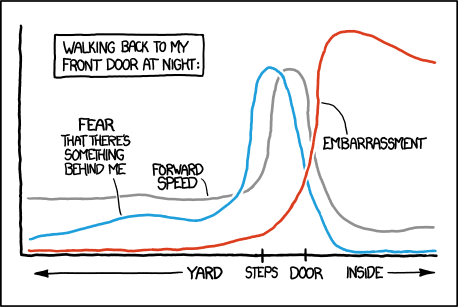
les gens si talentueux ont compris comment faire xkcd graphiques de style dans Mathematica , en LaTeX , en Python et dans R déjà.
comment peut-on utiliser MATLAB pour produire une parcelle qui ressemble à celle ci-dessus?
ce que j'ai essayé
I j'ai créé des lignes ondulées, mais je n'ai pas pu obtenir de haches ondulées. La seule solution à laquelle j'ai pensé était de les écraser avec des lignes ondulées, mais je veux pouvoir changer les axes actuels. Je ne pouvais pas non plus faire fonctionner la police Humor, le bit de code utilisé était:
annotation('textbox',[left+left/8 top+0.65*top 0.05525 0.065],...
'String',{'EMBARRASSMENT'},...
'FontSize',24,...
'FontName','Humor',...
'FitBoxToText','off',...
'LineStyle','none');
pour la ligne wiggly, j'ai expérimenté en ajoutant un petit bruit aléatoire et lissage:
smooth(0.05*randn(size(x)),10)
mais je n'ai pas pu faire apparaître le fond blanc autour d'eux quand ils se croisent...
4 réponses
je vois deux façons de résoudre cela: la première est d'ajouter un peu de jitter aux coordonnées x/y des caractéristiques de la parcelle. Cela a l'avantage que vous pouvez facilement modifier un tracé, mais vous devez dessiner les axes vous-même si vous voulez les faire xkcdyfier (voir @Rody Oldenhuis' solution ). La deuxième méthode consiste à créer une représentation graphique Non confuse, et à utiliser imtransform pour appliquer une distorsion aléatoire à l'image. Ceci a l'avantage que vous pouvez utiliser avec n'importe quel complot, mais vous va finir avec une image, pas un complot modifiable.
je vais montrer #2 d'abord, et ma tentative à #1 ci-dessous (si vous aimez mieux #1, regardez la solution de Rody !).
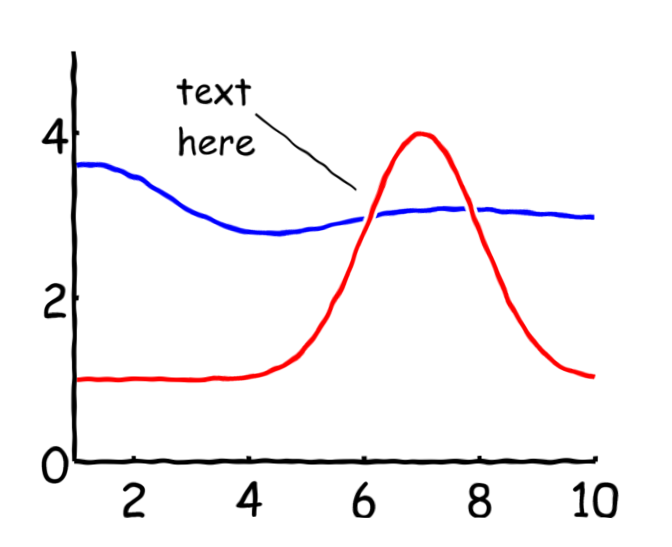
Cette solution repose sur deux fonctions clés: EXPORT_FIG de l'échange de fichiers pour obtenir une capture d'écran anti-aliasée, et IMTRANSFORM pour obtenir une transformation.
%# define plot data
x = 1:0.1:10;
y1 = sin(x).*exp(-x/3) + 3;
y2 = 3*exp(-(x-7).^2/2) + 1;
%# plot
fh = figure('color','w');
hold on
plot(x,y1,'b','lineWidth',3);
plot(x,y2,'w','lineWidth',7);
plot(x,y2,'r','lineWidth',3);
xlim([0.95 10])
ylim([0 5])
set(gca,'fontName','Comic Sans MS','fontSize',18,'lineWidth',3,'box','off')
%# add an annotation
annotation(fh,'textarrow',[0.4 0.55],[0.8 0.65],...
'string',sprintf('text%shere',char(10)),'headStyle','none','lineWidth',1.5,...
'fontName','Comic Sans MS','fontSize',14,'verticalAlignment','middle','horizontalAlignment','left')
%# capture with export_fig
im = export_fig('-nocrop',fh);
%# add a bit of border to avoid black edges
im = padarray(im,[15 15 0],255);
%# make distortion grid
sfc = size(im);
[yy,xx]=ndgrid(1:7:sfc(1),1:7:sfc(2));
pts = [xx(:),yy(:)];
tf = cp2tform(pts+randn(size(pts)),pts,'lwm',12);
w = warning;
warning off images:inv_lwm:cannotEvaluateTransfAtSomeOutputLocations
imt = imtransform(im,tf);
warning(w)
%# remove padding
imt = imt(16:end-15,16:end-15,:);
figure('color','w')
imshow(imt)
voici ma première tentative de jittering
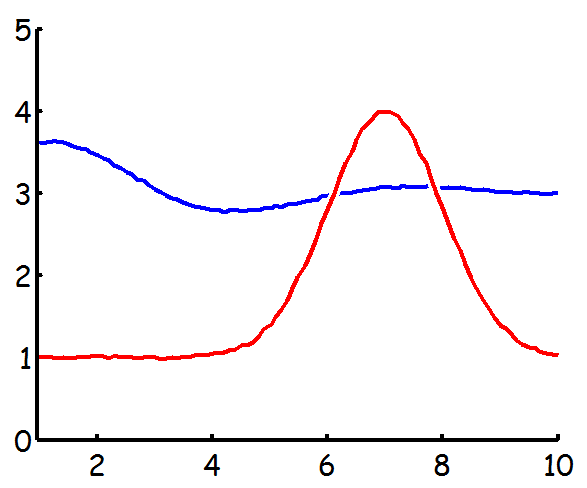
%# define plot data
x = 1:0.1:10;
y1 = sin(x).*exp(-x/3) + 3;
y2 = 3*exp(-(x-7).^2/2) + 1;
%# jitter
x = x+randn(size(x))*0.01;
y1 = y1+randn(size(x))*0.01;
y2 = y2+randn(size(x))*0.01;
%# plot
figure('color','w')
hold on
plot(x,y1,'b','lineWidth',3);
plot(x,y2,'w','lineWidth',7);
plot(x,y2,'r','lineWidth',3);
xlim([0.95 10])
ylim([0 5])
set(gca,'fontName','Comic Sans MS','fontSize',18,'lineWidth',3,'box','off')
plutôt que de ré-implémenter toutes les différentes fonctions de pointage j'ai voulu créer un outil générique qui pourrait convertir n'importe quelle parcelle existante en parcelle de style xkcd.
cette approche signifie que vous pouvez créer des parcelles et les style en utilisant la norme MATLAB fonctions et ensuite, lorsque vous avez terminé, vous pouvez re-rendre l'parcelle dans un style xkcd tout en préservant le style général de la parcelle.
exemples
parcelle
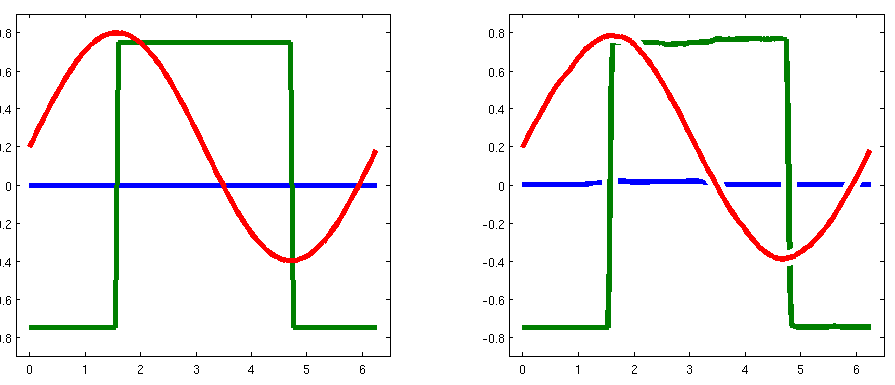
Bar & Complot
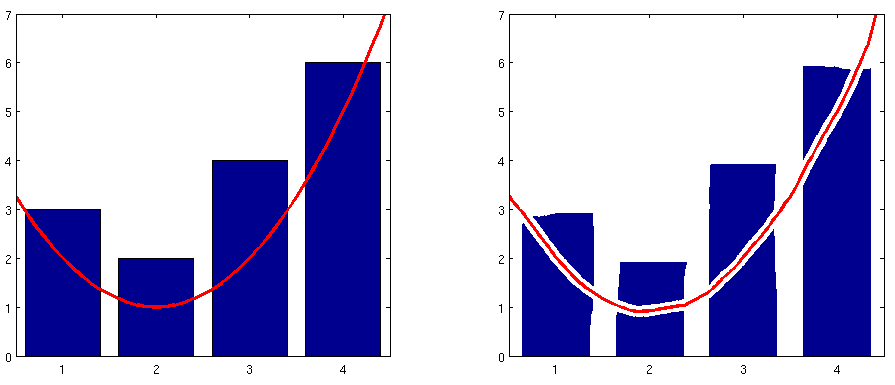
De Boîte Et De Complot
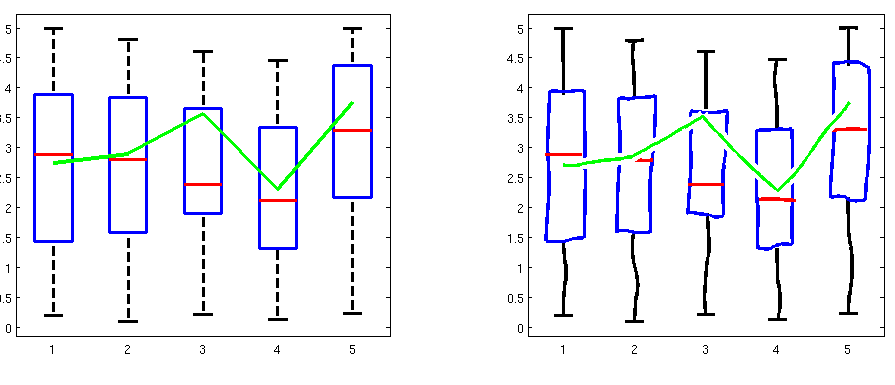
comment ça marche
la fonction fonctionne en itérant sur les enfants d'un axe. Si les enfants sont de type line ou patch il les déforme légèrement. Si l'enfant est de type hggroup , il est alors itéré sur les sous-enfants du hggroup . J'ai des plans pour supporter d'autres types d'intrigues, comme image , mais ce n'est pas clair quelle est la meilleure façon de déformer l'image pour avoir un style xkcd.
enfin pour s'assurer que les déformations semblent uniformes (c'est-à-dire que les lignes courtes ne sont pas distorties plus que les lignes longues), je mesure la longueur de la ligne en pixels puis je monte l'échantillon proportionnel à sa longueur. J'ajoute alors du bruit à chaque nième échantillon qui produit des lignes qui ont plus ou moins la même quantité de distorsion.
Le Code
plutôt que de coller plusieurs centaines de lignes de code, je vais juste lier à un gist de la source . En outre, le code source et le code pour générer les exemples ci-dessus sont librement disponibles GitHub .
comme vous pouvez le voir dans les exemples, il ne fausse pas encore les axes même si j'ai l'intention de mettre en œuvre dès que je figure sur la meilleure façon de le faire.
la première étape... trouvez une police système que vous aimez (utilisez la fonction listfonts pour voir ce qui est disponible) ou installez-en une qui correspond au style d'écriture de xkcd . J'ai trouvé une police "Humor Sans" TrueType de l'utilisateur ch00f mentionné dans ce billet de blog , et je l'utiliserai pour mes exemples suivants.
comme je le vois, vous aurez généralement besoin de trois différents modifié objets graphiques pour faire ce genre de graphiques: un objet axes , un objet ligne , et un objet texte . Vous pourriez aussi vouloir un objet d'annotation pour rendre les choses plus faciles, mais je prévois que pour l'instant comme il pourrait être plus difficile à mettre en œuvre que les trois objets ci-dessus.
j'ai créé des fonctions wrapper qui ont créé les trois objets, en outrepassant certains paramètres de propriété pour les rendre plus xkcd. Une limitation est que les nouveaux graphiques qu'ils produisent ne seront pas mis à jour dans certains cas (comme les boîtes de limites sur les objets de texte lors du redimensionnement des axes), mais cela pourrait être pris en compte avec une implémentation plus complète orientée objet qui implique d'hériter de la classe de poignée , en utilisant événements et auditeurs , etc. Pour l'instant, voici mes implémentations plus simples:
xkcd_axes.m:
function hAxes = xkcd_axes(xkcdOptions, varargin)
hAxes = axes(varargin{:}, 'NextPlot', 'add', 'Visible', 'off', ...
'XLimMode', 'manual', 'YLimMode', 'manual');
axesUnits = get(hAxes, 'Units');
set(hAxes, 'Units', 'pixels');
axesPos = get(hAxes, 'Position');
set(hAxes, 'Units', axesUnits);
xPoints = round(axesPos(3)/10);
yPoints = round(axesPos(4)/10);
limits = [xlim(hAxes) ylim(hAxes)];
ranges = [abs(limits(2) - limits(1)) abs(limits(4) - limits(3))];
backColor = get(get(hAxes, 'Parent'), 'Color');
xColor = get(hAxes, 'XColor');
yColor = get(hAxes, 'YColor');
line('Parent', hAxes, 'Color', xColor, 'LineWidth', 3, ...
'Clipping', 'off', ...
'XData', linspace(limits(1), limits(2), xPoints), ...
'YData', limits(3) + rand(1, xPoints).*0.005.*ranges(2));
line('Parent', hAxes, 'Color', yColor, 'LineWidth', 3, ...
'Clipping', 'off', ...
'YData', linspace(limits(3), limits(4), yPoints), ...
'XData', limits(1) + rand(1, yPoints).*0.005.*ranges(1));
xTicks = get(hAxes, 'XTick');
if ~isempty(xTicks)
yOffset = limits(3) - 0.05.*ranges(2);
tickIndex = true(size(xTicks));
if ismember('left', xkcdOptions)
tickIndex(1) = false;
xkcd_arrow('left', [limits(1) + 0.02.*ranges(1) xTicks(1)], ...
yOffset, xColor);
end
if ismember('right', xkcdOptions)
tickIndex(end) = false;
xkcd_arrow('right', [xTicks(end) limits(2) - 0.02.*ranges(1)], ...
yOffset, xColor);
end
plot([1; 1]*xTicks(tickIndex), ...
0.5.*[-yOffset; yOffset]*ones(1, sum(tickIndex)), ...
'Parent', hAxes, 'Color', xColor, 'LineWidth', 3, ...
'Clipping', 'off');
xLabels = cellstr(get(hAxes, 'XTickLabel'));
for iLabel = 1:numel(xLabels)
xkcd_text(xTicks(iLabel), yOffset, xLabels{iLabel}, ...
'HorizontalAlignment', 'center', ...
'VerticalAlignment', 'middle', ...
'BackgroundColor', backColor);
end
end
yTicks = get(hAxes, 'YTick');
if ~isempty(yTicks)
xOffset = limits(1) - 0.05.*ranges(1);
tickIndex = true(size(yTicks));
if ismember('down', xkcdOptions)
tickIndex(1) = false;
xkcd_arrow('down', xOffset, ...
[limits(3) + 0.02.*ranges(2) yTicks(1)], yColor);
end
if ismember('up', xkcdOptions)
tickIndex(end) = false;
xkcd_arrow('up', xOffset, ...
[yTicks(end) limits(4) - 0.02.*ranges(2)], yColor);
end
plot(0.5.*[-xOffset; xOffset]*ones(1, sum(tickIndex)), ...
[1; 1]*yTicks(tickIndex), ...
'Parent', hAxes, 'Color', yColor, 'LineWidth', 3, ...
'Clipping', 'off');
yLabels = cellstr(get(hAxes, 'YTickLabel'));
for iLabel = 1:numel(yLabels)
xkcd_text(xOffset, yTicks(iLabel), yLabels{iLabel}, ...
'HorizontalAlignment', 'right', ...
'VerticalAlignment', 'middle', ...
'BackgroundColor', backColor);
end
end
function xkcd_arrow(arrowType, xArrow, yArrow, arrowColor)
if ismember(arrowType, {'left', 'right'})
xLine = linspace(xArrow(1), xArrow(2), 10);
yLine = yArrow + rand(1, 10).*0.003.*ranges(2);
arrowScale = 0.05.*ranges(1);
if strcmp(arrowType, 'left')
xArrow = xLine(1) + arrowScale.*[0 0.5 1 1 1 0.5];
yArrow = yLine(1) + arrowScale.*[0 0.125 0.25 0 -0.25 -0.125];
else
xArrow = xLine(end) - arrowScale.*[0 0.5 1 1 1 0.5];
yArrow = yLine(end) + arrowScale.*[0 -0.125 -0.25 0 0.25 0.125];
end
else
xLine = xArrow + rand(1, 10).*0.003.*ranges(1);
yLine = linspace(yArrow(1), yArrow(2), 10);
arrowScale = 0.05.*ranges(2);
if strcmp(arrowType, 'down')
xArrow = xLine(1) + arrowScale.*[0 0.125 0.25 0 -0.25 -0.125];
yArrow = yLine(1) + arrowScale.*[0 0.5 1 1 1 0.5];
else
xArrow = xLine(end) + arrowScale.*[0 -0.125 -0.25 0 0.25 0.125];
yArrow = yLine(end) - arrowScale.*[0 0.5 1 1 1 0.5];
end
end
line('Parent', hAxes, 'Color', arrowColor, 'LineWidth', 3, ...
'Clipping', 'off', 'XData', xLine, 'YData', yLine);
patch('Parent', hAxes, 'FaceColor', arrowColor, ...
'EdgeColor', arrowColor, 'LineWidth', 2, 'Clipping', 'off', ...
'XData', xArrow + [0 rand(1, 5).*0.002.*ranges(1)], ...
'YData', yArrow + [0 rand(1, 5).*0.002.*ranges(2)]);
end
end
xkcd_text.m:
function hText = xkcd_text(varargin)
hText = text(varargin{:});
set(hText, 'FontName', 'Humor Sans', 'FontSize', 13, ...
'FontWeight', 'normal');
backColor = get(hText, 'BackgroundColor');
edgeColor = get(hText, 'EdgeColor');
if ~strcmp(backColor, 'none') || ~strcmp(edgeColor, 'none')
hParent = get(hText, 'Parent');
extent = get(hText, 'Extent');
nLines = size(get(hText, 'String'), 1);
extent = extent + [-0.5 -0.5 1 1].*0.25.*extent(4)./nLines;
yPoints = 5*nLines;
xPoints = round(yPoints*extent(3)/extent(4));
noiseScale = 0.05*extent(4)/nLines;
set(hText, 'BackgroundColor', 'none', 'EdgeColor', 'none');
xBox = [linspace(extent(1), extent(1) + extent(3), xPoints) ...
extent(1) + extent(3) + noiseScale.*rand(1, yPoints) ...
linspace(extent(1) + extent(3), extent(1), xPoints) ...
extent(1) + noiseScale.*rand(1, yPoints)];
yBox = [extent(2) + noiseScale.*rand(1, xPoints) ...
linspace(extent(2), extent(2) + extent(4), yPoints) ...
extent(2) + extent(4) + noiseScale.*rand(1, xPoints) ...
linspace(extent(2) + extent(4), extent(2), yPoints)];
patch('Parent', hParent, 'FaceColor', backColor, ...
'EdgeColor', edgeColor, 'LineWidth', 2, 'Clipping', 'off', ...
'XData', xBox, 'YData', yBox);
hKids = get(hParent, 'Children');
set(hParent, 'Children', [hText; hKids(hKids ~= hText)]);
end
end
xkcd_line.m:
function hLine = xkcd_line(xData, yData, varargin)
yData = yData + 0.01.*max(range(xData), range(yData)).*rand(size(yData));
line(xData, yData, varargin{:}, 'Color', 'w', 'LineWidth', 8);
hLine = line(xData, yData, varargin{:}, 'LineWidth', 3);
end
et voici un exemple de script qui les utilise pour recréer la bande dessinée ci-dessus. J'ai recréé les lignes en utilisant ginput pour marquer des points dans l'intrigue avec la souris, les capturer, puis les tracer comme je voulais:
xS = [0.0359 0.0709 0.1004 0.1225 0.1501 0.1759 0.2219 0.2477 0.2974 0.3269 0.3582 0.3895 0.4061 0.4337 0.4558 0.4797 0.5074 0.5276 0.5589 0.5810 0.6013 0.6179 0.6271 0.6344 0.6381 0.6418 0.6529 0.6713 0.6842 0.6934 0.7026 0.7118 0.7265 0.7376 0.7560 0.7726 0.7836 0.7965 0.8149 0.8370 0.8573 0.8867 0.9033 0.9346 0.9659 0.9843 0.9936];
yS = [0.2493 0.2520 0.2548 0.2548 0.2602 0.2629 0.2629 0.2657 0.2793 0.2657 0.2575 0.2575 0.2602 0.2629 0.2657 0.2766 0.2793 0.2875 0.3202 0.3856 0.4619 0.5490 0.6771 0.7670 0.7970 0.8270 0.8433 0.8433 0.8243 0.7180 0.6199 0.5272 0.4510 0.4128 0.3392 0.2711 0.2275 0.1757 0.1485 0.1131 0.1022 0.0858 0.0858 0.1022 0.1267 0.1567 0.1594];
xF = [0.0304 0.0488 0.0727 0.0967 0.1335 0.1630 0.2090 0.2348 0.2698 0.3011 0.3269 0.3545 0.3803 0.4153 0.4466 0.4724 0.4945 0.5110 0.5350 0.5516 0.5608 0.5700 0.5755 0.5810 0.5884 0.6013 0.6179 0.6363 0.6492 0.6584 0.6676 0.6731 0.6842 0.6860 0.6934 0.7007 0.7136 0.7265 0.7394 0.7560 0.7726 0.7818 0.8057 0.8444 0.8794 0.9107 0.9475 0.9751 0.9917];
yF = [0.0804 0.0940 0.0967 0.1049 0.1185 0.1458 0.1512 0.1540 0.1649 0.1812 0.1812 0.1703 0.1621 0.1594 0.1703 0.1975 0.2411 0.3065 0.3801 0.4782 0.5708 0.6526 0.7452 0.8106 0.8324 0.8488 0.8433 0.8270 0.7888 0.7343 0.6826 0.5981 0.5300 0.4782 0.3910 0.3420 0.2847 0.2248 0.1621 0.0995 0.0668 0.0395 0.0232 0.0177 0.0204 0.0232 0.0259 0.0204 0.0232];
xE = [0.0267 0.0488 0.0856 0.1409 0.1759 0.2164 0.2514 0.3011 0.3269 0.3637 0.3969 0.4245 0.4503 0.4890 0.5313 0.5608 0.5939 0.6344 0.6694 0.6934 0.7192 0.7394 0.7523 0.7689 0.7891 0.8131 0.8481 0.8757 0.9070 0.9346 0.9604 0.9807 0.9936];
yE = [0.0232 0.0232 0.0232 0.0259 0.0259 0.0259 0.0313 0.0259 0.0259 0.0259 0.0368 0.0395 0.0477 0.0586 0.0777 0.0886 0.1213 0.1730 0.2466 0.2902 0.3638 0.5082 0.6499 0.7916 0.8924 0.9414 0.9550 0.9387 0.9060 0.8760 0.8542 0.8379 0.8188];
hFigure = figure('Position', [300 300 700 450], 'Color', 'w');
hAxes = xkcd_axes({'left', 'right'}, 'XTick', [0.45 0.60 0.7 0.8], ...
'XTickLabel', {'YARD', 'STEPS', 'DOOR', 'INSIDE'}, ...
'YTick', []);
hSpeed = xkcd_line(xS, yS, 'Parent', hAxes, 'Color', [0.5 0.5 0.5]);
hFear = xkcd_line(xF, yF, 'Parent', hAxes, 'Color', [0 0.5 1]);
hEmb = xkcd_line(xE, yE, 'Parent', hAxes, 'Color', 'r');
hText = xkcd_text(0.27, 0.9, ...
{'WALKING BACK TO MY'; 'FRONT DOOR AT NIGHT:'}, ...
'Parent', hAxes, 'EdgeColor', 'k', ...
'HorizontalAlignment', 'center');
hSpeedNote = xkcd_text(0.36, 0.35, {'FORWARD'; 'SPEED'}, ...
'Parent', hAxes, 'Color', 'k', ...
'HorizontalAlignment', 'center');
hSpeedLine = xkcd_line([0.4116 0.4282 0.4355 0.4411], ...
[0.3392 0.3256 0.3038 0.2820], ...
'Parent', hAxes, 'Color', 'k');
hFearNote = xkcd_text(0.15, 0.45, {'FEAR'; 'THAT THERE''S'; ...
'SOMETHING'; 'BEIND ME'}, ...
'Parent', hAxes, 'Color', 'k', ...
'HorizontalAlignment', 'center');
hFearLine = xkcd_line([0.1906 0.1998 0.2127 0.2127 0.2201 0.2256], ...
[0.3501 0.3093 0.2629 0.2221 0.1975 0.1676], ...
'Parent', hAxes, 'Color', 'k');
hEmbNote = xkcd_text(0.88, 0.45, {'EMBARRASSMENT'}, ...
'Parent', hAxes, 'Color', 'k', ...
'HorizontalAlignment', 'center');
hEmbLine = xkcd_line([0.8168 0.8094 0.7983 0.7781 0.7578], ...
[0.4864 0.5436 0.5872 0.6063 0.6226], ...
'Parent', hAxes, 'Color', 'k');
Et (trompettes) ici est la résultante de l'intrigue!:
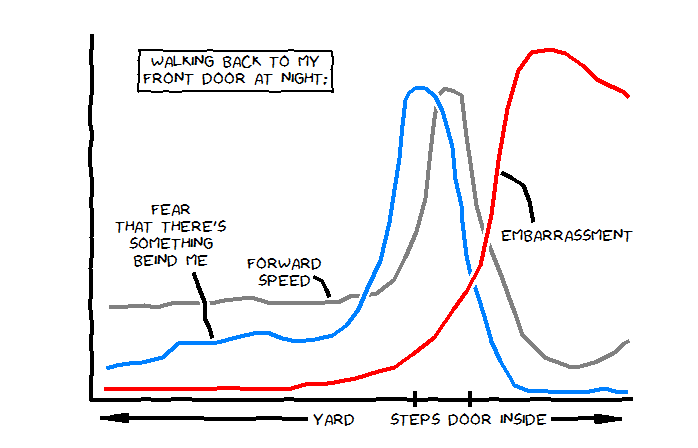
OK alors, voici ma tentative moins-cru-mais-pas-tout-encore-là:
%# init
%# ------------------------
noise = @(x,A) A*randn(size(x));
ns = @(x,A) A*ones(size(x));
h = figure(2); clf, hold on
pos = get(h, 'position');
set(h, 'position', [pos(1:2) 800 450]);
blackline = {
'k', ...
'linewidth', 2};
axisline = {
'k', ...
'linewidth', 3};
textprops = {
'fontName','Comic Sans MS',...
'fontSize', 14,...
'lineWidth',3};
%# Plot data
%# ------------------------
x = 1:0.1:10;
y0 = sin(x).*exp(-x/30) + 3;
y1 = sin(x).*exp(-x/3) + 3;
y2 = 3*exp(-(x-7).^6/.05) + 1;
y0 = y0 + noise(x, 0.01);
y1 = y1 + noise(x, 0.01);
y2 = y2 + noise(x, 0.01);
%# plot
plot(x,y0, 'color', [0.7 0.7 0.7], 'lineWidth',3);
plot(x,y1, 'w','lineWidth',7);
plot(x,y1, 'b','lineWidth',3);
plot(x,y2, 'w','lineWidth',7);
plot(x,y2, 'r','lineWidth',3);
%# text
%# ------------------------
ll(1) = text(1.3, 4.2,...
{'Walking back to my'
'front door at night:'});
ll(2) = text(5, 0.7, 'yard');
ll(3) = text(6.2, 0.7, 'steps');
ll(4) = text(7, 0.7, 'door');
ll(5) = text(8, 0.7, 'inside');
set(ll, textprops{:});
%# arrows & lines
%# ------------------------
%# box around "walking back..."
xx = 1.2:0.1:3.74;
yy = ns(xx, 4.6) + noise(xx, 0.007);
plot(xx, yy, blackline{:})
xx = 1.2:0.1:3.74;
yy = ns(xx, 3.8) + noise(xx, 0.007);
plot(xx, yy, blackline{:})
yy = 3.8:0.1:4.6;
xx = ns(yy, 1.2) + noise(yy, 0.007);
plot(xx, yy, blackline{:})
xx = ns(yy, 3.74) + noise(yy, 0.007);
plot(xx, yy, blackline{:})
%# left arrow
x_arr = 1.2:0.1:4.8;
y_arr = 0.65 * ones(size(x_arr)) + noise(x_arr, 0.005);
plot(x_arr, y_arr, blackline{:})
x_head = [1.1 1.6 1.62];
y_head = [0.65 0.72 0.57];
patch(x_head, y_head, 'k')
%# right arrow
x_arr = 8.7:0.1:9.8;
y_arr = 0.65 * ones(size(x_arr)) + noise(x_arr, 0.005);
plot(x_arr, y_arr, blackline{:})
x_head = [9.8 9.3 9.3];
y_head = [0.65 0.72 0.57];
patch(x_head, y_head, 'k')
%# left line on axis
y_line = 0.8:0.1:1.1;
x_line = ns(y_line, 6.5) + noise(y_line, 0.005);
plot(x_line, y_line, blackline{:})
%# right line on axis
y_line = 0.8:0.1:1.1;
x_line = ns(y_line, 7.2) + noise(y_line, 0.005);
plot(x_line, y_line, blackline{:})
%# axes
x_xax = x;
y_xax = 0.95 + noise(x_xax, 0.01);
y_yax = 0.95:0.1:5;
x_yax = x(1) + noise(y_yax, 0.01);
plot(x_xax, y_xax, axisline{:})
plot(x_yax, y_yax, axisline{:})
% finalize
%# ------------------------
xlim([0.95 10])
ylim([0 5])
axis off
résultat:
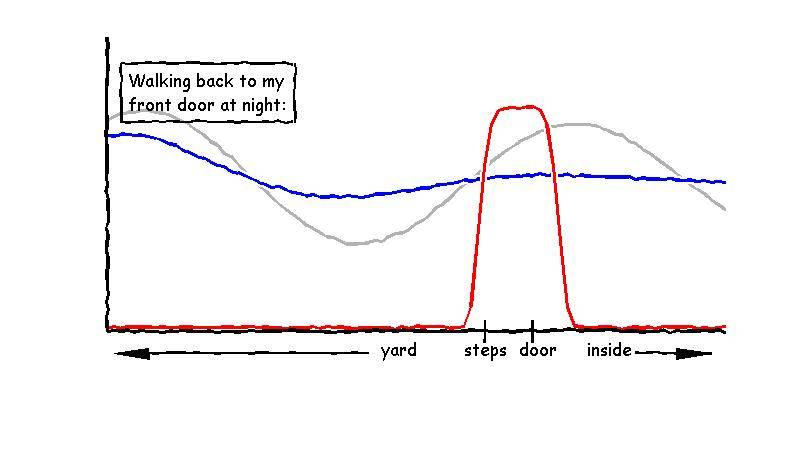
choses à faire:
- trouver de meilleures fonctions (mieux les définir au niveau des pièces)
- ajouter "annotations" et lignes ondulées aux courbes qu'ils décrivent
- trouvez une meilleure police que Comic Sans!
- généraliser tout dans une fonction
plot2xkcdde sorte que nous pouvons convertir n'importe quel parcelle/figure au style xkcd.